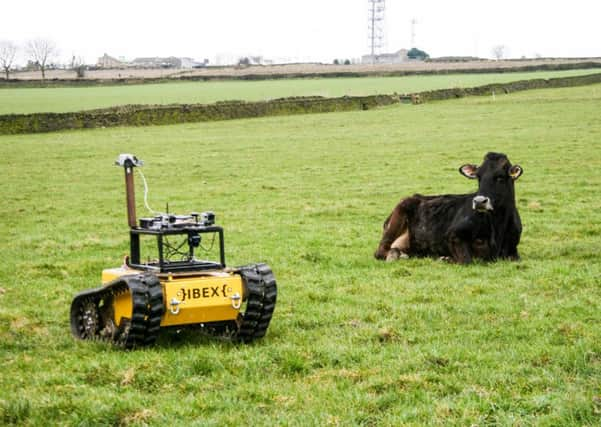South Yorkshire farm at the centre of robotic farmer plans


Inspired by advances in bomb disposal technology, farmer’s son Charles Fox and his old university friend Ed Gummow have created a prototype robotic farmer that has been programmed to automatically treat weeds on rough, steep agricultural terrain, so the farmer doesn’t have to.
For more than 250 years land in and around the hamlet of Greenmor near Sheffield, known locally as the Echoing Hills, has been farmed by members of the Fox family. It is Charles, 36, and his father, CLA member Bruce Fox, who work the 200-acre Hunshelf Hall farm today, but Charles knows that relying on the troubled dairy sector is risky and so he has set his sights on leading a robotic revolution which he hopes will be a commercial success.
Advertisement
Hide AdAdvertisement
Hide AdInspiration for the robotic farmer came while he was completing a PhD at Oxford University. On a visit home, Charles, 36, was helping to spray weeds with a knapsack when he realised that it was a task that could be automated.
“I had no interest in farming myself until I realised that lots of the same robotics and automation ideas from my PhD were starting to appear in the farming press,” said Charles, who also has a degree in computer science.
“As I walked around the farm, spraying the weeds, it dawned on me that this was the ideal task to start bringing the two parts of my life together.”
Enlisting the help of Ed, who had set up a robotic engineering business in the Midlands and had built bomb disposal machines for the military, they designed a robot that would be capable of spraying weeds on remote upland farms.
Advertisement
Hide AdAdvertisement
Hide AdCharles said: “We went through a number of prototypes, smashing up chassis and crunching gears until we came up with something that was fit for purpose.”
The result is a three-foot robotic farmer that drives itself, or is remotely operated, around grasslands identifying and destroying weeds. It can tackle inclines of up to 45 per cent and can pull weights of up to three tonnes. On board sensors linked to GPS mapping allow it to navigate - including terrain too dangerous to reach by tractor or quad bike - and a robotic arm sprays targeted, small patches of weeds, around 30cm in diameter.
“We’ve uploaded 40,000 images of weeds but if in doubt it will not spray a plant,” Charles explained.
Charles used ‘Bayesian probability theory’ to reduce production costs, using cheaper components but enabling the robots to compensate for any shortcomings in performance.
Advertisement
Hide AdAdvertisement
Hide Ad“Robots are usually programmed to perform specific tasks. Instead, we are uploading large amounts of data about the environment in which the robot will be operating and effectively allowing it to learn the bigger picture. We can use cheaper cameras, guiding lasers and GPS units and, rather than rely exclusively on the data it receives from them, the robot will also take in to account factors it already knows about its surroundings. If any of the components fail or malfunction the robot is intelligent enough to compensate for it.”
The robot cost around £250,000 to develop, with three-quarters of the funding from Innovate UK on behalf of Defra. Trials will be completed later this year and Charles and Ed hope the units will sell for around £10,000 each.
Charles believes it can reduce fuel costs, labour and the environmental impact of bulk herbicide spraying.
He said: “As we’re witnessing with the advent of driver-less cars, technology in this field is moving forward at quite a pace. Paradoxically, in agriculture this is allowing us to move back to more traditional methods of precision farming only this time, instead of a horse working the fields, it is a robot.”
To take the project forward, Charles and Ed set up IBEX, a consortium bringing together their businesses and another mechanical engineering firm.